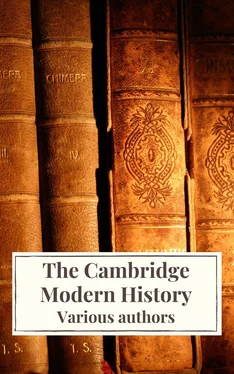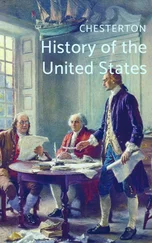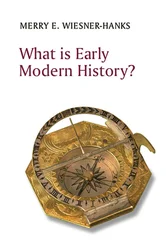R. Nisbet Bain - The Cambridge Modern History
Здесь есть возможность читать онлайн «R. Nisbet Bain - The Cambridge Modern History» — ознакомительный отрывок электронной книги совершенно бесплатно, а после прочтения отрывка купить полную версию. В некоторых случаях можно слушать аудио, скачать через торрент в формате fb2 и присутствует краткое содержание. Жанр: unrecognised, на английском языке. Описание произведения, (предисловие) а так же отзывы посетителей доступны на портале библиотеки ЛибКат.
- Название:The Cambridge Modern History
- Автор:
- Жанр:
- Год:неизвестен
- ISBN:нет данных
- Рейтинг книги:4 / 5. Голосов: 1
-
Избранное:Добавить в избранное
- Отзывы:
-
Ваша оценка:
- 80
- 1
- 2
- 3
- 4
- 5
The Cambridge Modern History: краткое содержание, описание и аннотация
Предлагаем к чтению аннотацию, описание, краткое содержание или предисловие (зависит от того, что написал сам автор книги «The Cambridge Modern History»). Если вы не нашли необходимую информацию о книге — напишите в комментариях, мы постараемся отыскать её.
The first series was planned by Lord Acton and edited by him with Stanley Leathes, Adolphus Ward and George Prothero.
The Cambridge Modern History Collection features all five original volumes:
Volume I: The Renaissance
Volume II: The Reformation, the End of the Middle Ages
Volume III The Wars of Religion
Volume IV: The 30 Years' War
Volume V: The Age of Louis XIV
The Cambridge Modern History — читать онлайн ознакомительный отрывок
Ниже представлен текст книги, разбитый по страницам. Система сохранения места последней прочитанной страницы, позволяет с удобством читать онлайн бесплатно книгу «The Cambridge Modern History», без необходимости каждый раз заново искать на чём Вы остановились. Поставьте закладку, и сможете в любой момент перейти на страницу, на которой закончили чтение.
Интервал:
Закладка:
In the nineteenth year of his efforts to reach Bilad Ghana the Iffante thus saw them at length crowned with success; and his licensees pursued the trade thus opened up so vigorously that in 1448, seven years after the capture of the first natives, and three years after the Senegal had been reached, not less than 927 African slaves had been brought to the Portuguese markets, the greater part of whom, it is unctuously observed by Zurara, were converted to the true way of salvation. The rich field of commerce thus entered upon was rapidly developed by the continued exploration of the coast. We have seen that even before the Iffante’s emissaries anchored at the mouth of the Senegal a navigator standing further out to sea claimed to have passed it, and reached Cape Verde. The year in which the Senegal river was actually reached (1445) was marked by another important advance. The Venetian captain Ca da Mosto and the Genoese Antonio de Nola, both in the Iffante’s employ, passed beyond Cape Verde, and reached the Gambia river; the Iffante began also in this year the colonisation of San Miguel, which had been reached in the previous year, and was the second among the Azores Islands in order of discovery. In 1446 Ca da Mosto and Antonio de Nola not only discovered the four Cape Verde Islands, Boavista, Santiago, San Filippe, and San Cristovao, but passed Capo Roxo, far beyond the Gambia River, and coasted the shore to an equal distance beyond Capo Roxo, discovering the rivers Sant’ Anna, San Domingos, and Rio Grande. From the coast south of Cape Verde new wonders were brought back to Portugal. The Iffante’s eyes were gladdened by beholding tusks of the African elephant, and a living African lion.
How far southward along the coast the Iffante’s licensees had actually sailed at the time of his death (1460), is uncertain. Could the distances reported by them as expressed in nautical leagues be accepted as trustworthy evidence, they must have passed the Bissagos and De Los Islands, and here reached the latitude of Sierra Leone, only eight degrees north of the equator. But the estimates given in the chronicle, founded only on dead reckoning, are in excess of actual geographical distances. We doubt whether before Dom Henrique’s death Portuguese seamen had passed the tenth parallel of north latitude; and it is known that in his last years the complete discovery and colonisation of the Azores group chiefly occupied his attention. Dom Henrique’s will, which specifies churches founded by him in each of the Azores, in Madeira, Porto Santo, and Deserta, as well as in various towns of Portugal and on the opposite coast of Morocco, speaks of the great dependency of Guinea, which he had secured for the Portuguese Crown, in general terms only. He looked on it as a certain source, in the future, of large ecclesiastical revenues. These, following a common practice of the age, were settled by him, with the Pope’s assent, on the military and religious Order of which he was governor. Guinea was to be parcelled into parishes, each having a stipendiary vicar or chaplain, charged for ever with the duty of saying “ one weekly mass of St Mary “ for the Iffante’s soul. We find nothing about the circumnavigation of Africa, or the extension of the enterprise to the Indian Ocean. Down to his death he probably expected that a junction with the Christians of Abyssinia and the East would be ultimately affected by ascending the Western Nile or Senegal River to its sources, which were universally supposed to be near those of the Egyptian Nile. This expectation, however, he associated with the remote future; his present policy was to secure Guinea as a dependency for Portugal and a rich appanage for the Order of Christ, by the construction of forts, the establishment of parochial settlements, and the foundation of churches. The economic character of the Iffante’s enterprise was felt, even in his lifetime, to be so little in accordance with the character which history demands for its heroes, that a contemporary chronicle of the Guinea expeditions, compiled by one Cerveira, is known to have been suppressed, and replaced by the garbled work of Zurara, whose object it was to write the Iffante’s panegyric as a great soldier and eminent Christian, and as the patriotic founder of the Greater Portugal which posterity would never cease to associate with his name. As the enterprise assumed larger proportions, the pretence that the negro was captured and shipped to Portugal for the salvation of his soul was abandoned. Even more valuable, for commercial purposes, than negro slaves, were the gold and ivory in which the tribes south of the Gambia River abounded. The Portuguese, who were now expert slave-raiders, found that the reward of their enterprise was best secured by disposing of their prey to the chiefs of other tribes, who were ready to give gold and ivory in exchange. The Guinea trade, which assumed this character almost exclusively soon after Dom Henrique’s death, was now farmed out to the highest bidders. Affonso V in 1469 granted it to one Fernam Gomes for five years, at an annual rent of 500 crusados, on condition that the grantee should in each year discover a hundred leagues of coast, or five hundred leagues altogether during the term. Pursuant to these conditions Gomes pushed the task of exploration vigorously forward. His sailors rounded Cape Palmas, the south-western extremity of North Africa, whence the coast trends to the north-east, passed the “Ivory Coast,” and reached what has ever since been known as “the Gold Coast11 in a special sense-the land of the Fantee, having as a background the mountains of Ashantee; and here, a few years later, Joao II founded the fort of San Jorge da Mina, the first great permanent fortress of the Portuguese on the Guinea coast. Before the death of Affonso V (1481), his subjects had coasted along the kingdoms of Dahomey and Benin, passed the delta of the Niger, crossed the bight of Biafra, where the coast at length bends to southward, discovered the island of Fernam do Po, followed the southwards-trending coast-line past Cape Lopez, and reached Cape St Catherine, two degrees south of the equator. These explorations proved that the general outline of Southern Africa had been correctly traced on Italian charts dating from the preceding century; and the last steps in the process of exploration, which finally verified this outline, were taken with extraordinary rapidity. In 1484 Diego Cam reached the mouth of the Congo, sailed a short way up the river, and brought back with him four natives, who quickly acquired enough Portuguese to communicate important information regarding their own country and the coast beyond it. Returning with them in 1485, he proceeded some distance to the southward, but made no extensive discoveries; nor was it until the following year that Bartolomeo Diaz, charged by Joao II with the task of following the continent to its southern extremity, passed from the mouth of the Congo two degrees beyond the southern tropic, and reached the Sierra Parda, near Angra Pequena. From this point he resolved to stand out to sea, instead of following the shore. Strong westerly gales drove him back towards it; and he at length reached Mossel Bay, named by him Bahia dos Vaqueiros, from the herdsmen who pastured their flocks on its shore. He was now on the southern coast of Africa, having circumnavigated the Cape of Good Hope unawares. From this point Diaz followed the coast past Algoa Bay as far as the Great Fish River. Its trend being now unmistakably to the north-east, he knew that he had accomplished his task. Returning towards the Cape, to which he gave the name Cabo Tormentoso, or Cape Tempestuous, he rounded it in the reverse direction to that which he had at first intended, and returned to Portugal.
As the Portuguese exploration of the African coast proceeded during sixty years, the objects with which it was pursued were almost completely transformed; and it illustrates perhaps more aptly than any other episode in European history the transition from the ideas of the crusading age to those of the age of dominant commerce and colonisation. Dom Henrique’s conception of a “ Greater Portugal” including the island groups of the Atlantic and Bilad Ghana on the Senegal River certainly recalls, and was probably founded on, the Mohammadan dominion which included Southern Spain, the Balearic Islands, and Northern Africa, and which St Louis proposed to replace by a Christian dominion equally comprehensive. To this strictly medieval conception the Iffante added some dim idea of a junction with the Christian sovereign of Abyssinia, to be effected by ascending the Western Nile. Beyond this point we have no reason to conclude that his imagination ever wandered. The transformation began after his death. The new dominion called “Guinea” was ascertained by a rapidly extending process of exploration to be of enormous size; this modest province, as it had seemed in prospect, assumed the proportions and character of a vast and hitherto unknown continent. Twenty-six years of discovery, after the Iffante’s death, revealed three times the length of coast which had been made known in the course of a considerably longer period during his lifetime; and the Portuguese sailors had now been brought within measurable distance of the Red Sea and Persian Gulf of India, China, and the Spice Islands. Europe’s commerce with the East-an object far exceeding in importance the conquest of Guinea-was evidently within the grasp of Portugal. Ten years elapsed, and a transcendent effort of seamanship had to be made, before actual possession was taken of the prize. Meanwhile, the geographical knowledge attained during these twenty-six years wrought like a ferment in the minds of European observers. It was felt that the little kingdom of Portugal had effected something like a revolution in the intellectual world: and the ideas inspired by this change, while the existence of the New World, called afterwards America, was as yet unsuspected, are admirably expressed in an epistle addressed to Joao II by Angiolo Poliziano, professor of Greek and Latin literature at Florence. The foremost scholar of the Renaissance tenders to the Portuguese King the thanks of cultivated Europe. Not only have the Pillars of Hercules been left behind, and a raging ocean subdued, but the interrupted continuity of the habitable world has been restored, and a continent long abandoned to savagery, representing one-third of the habitable world, has been recovered for Christianity and civilisation. What new commodities and economic advantages, what accessions to knowledge, what confirmations of ancient history, heretofore rejected as incredible, may now be expected! New lands, new seas, new worlds (alii mundi), even new constellations, have been dragged from secular darkness into the light of day. Portugal stands forth the trustee, the guardian, of a second world (mundus alter), holding in the hollow of her hand a vast series of lands, ports, seas, and islands, revealed by the industry of her sons and the enterprise of her Kings. The purpose of Politian’s epistle is to suggest that the story of this momentous acquisition should be adequately written while the memorials of it are yet fresh and complete, and to this end he offers his own services. Its significance for ourselves lies in the fact that his admiration is couched in terms which would apply with equal or greater propriety to the impending discovery of the western continent. The existence of America was as yet unsuspected : and the mental fermentation produced in Europe by the Portuguese voyages quickly led to its discovery. To cosmographers this fermentation irresistibly suggested the revival of an idea evolved eighteen hundred years previously by Greek geographers from the consideration of the recently ascertained sphericity of the earth and the approximate dimensions of its known continental areas. A few days1 sail, with a fair wind, it had been long ago contended, would suffice to carry a ship from the shores of Spain, by a westward course, to the eastern shores of Asia. The argument had never been wholly lost sight of; and the revival of science in the thirteenth century had once more brought it into prominence. Roger Bacon had given it a conspicuous place in his speculations as to the distribution of land and ocean over the globe. One is even tempted to think that those adventurous Genoese who in 1281 passed the Straits of Gibraltar with two vessels, intending to make their way to the Indies, and were never again heard of, prematurely sought to bring it to the test of experience; but the better opinion is that they merely proposed to circumnavigate South Africa. As the African coast was progressively explored by the Portuguese and laid down on the chart, the realisation of the idea of reaching the East by way of the West became a practical matter. While Gomes was pushing forward the exploration of Southern Guinea, a canon of Lisbon, on a visit to Florence, consulted Toscanelli, the most celebrated of Italian physicists, on the feasibility of such a voyage, and brought back to Affonso V a verbal opinion favourable to it; and this opinion was shortly confirmed by a letter and a chart on which the proposed westward course was laid down. Twelve years were yet to pass before Diaz reached the Cape of Good Hope; the time for testing the scheme had not fully come. But as the Portuguese ships drew nearer to their goal, the western voyage more and more attracted attention; and the idea gained countenance through the extension of maritime enterprise further and further into the unknown westward expanses of the Atlantic Ocean, pursuant to the development of a Greater Portugal according to Dom Henrique’s design.
Читать дальшеИнтервал:
Закладка:
Похожие книги на «The Cambridge Modern History»
Представляем Вашему вниманию похожие книги на «The Cambridge Modern History» списком для выбора. Мы отобрали схожую по названию и смыслу литературу в надежде предоставить читателям больше вариантов отыскать новые, интересные, ещё непрочитанные произведения.
Обсуждение, отзывы о книге «The Cambridge Modern History» и просто собственные мнения читателей. Оставьте ваши комментарии, напишите, что Вы думаете о произведении, его смысле или главных героях. Укажите что конкретно понравилось, а что нет, и почему Вы так считаете.












